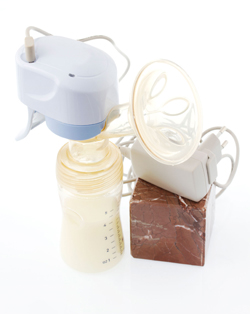January 23, 2012 - By Erin Digitale

Gianni Furlan/Photos.com
While feeding breast milk to a tiny preterm baby can be a serious challenge, new Stanford research shows that it may be well worth the effort: breast milk that is produced by a combination of hand-expression and electronic pumping provides distinct nutritional benefits.
The findings could affect the debate about whether human milk is rich enough for preemies. These babies are often fed human milk supplemented with powdered cow’s milk protein to give more calories per gulp.
Preemies born eight or more weeks early can’t breastfeed as they lack the reflex needed to coordinate swallowing and breathing. Even more-mature preemies often fail to suckle aggressively enough to get the nourishment they need. This poses a problem for preemies’ moms, who often want to provide breast milk but don’t have a baby at the breast. How can they supply the most nutritious milk to their child while also ensuring their bodies make enough milk?
A Stanford/Packard Children's team recently published the second of two papers showing that a combination of electric pumping and hand expression can get mom’s milk production up to speed. The first paper demonstrated that mothers who combined electric pumping sessions with manual techniques, such as hands-on compressions of the breast, extracted more milk and boosted their long-term milk production even above levels required by 4-month-old term infants.
The new paper, which appeared Jan. 5 in the Journal of Perinatology, evaluated the nutrient composition of milk from 52 mothers of very early preemies who combined electric and hands-on pumping methods.
“People have suspected that mothers would be able to get more fat-rich milk with hands-on pumping but it’s never been demonstrated before,” said Jane Morton, MD, a community pediatrician who was the new paper’s first author. The suspicion arose because milk composition changes during a feeding, shifting from more-dilute milk at first to richer, higher-fat “hindmilk” at the end. Because of its high fat content, the hindmilk is more viscous, which may explain why it’s difficult to remove this milk with an electric pump alone. But extracting more high-fat hindmilk could give preemies an important calorie boost.
The researchers’ findings confirmed that moms who used hands-on pumping had higher fat content in their milk than women relying on electric pumps alone. Based on previous research on human milk, the team believes babies could benefit in several ways from the higher-fat milk, in addition to consuming the extra calories it supplies: human milk fat is better absorbed than fat from cow’s milk formula; the polyunsaturated fats in human milk are especially beneficial for brain development; and the presence of extra fat makes it easier for babies to absorb fat-soluble vitamins from the milk. “There seems to be real value added” by the hands-on pumping, Morton said.
The next research steps, Morton said, are replicating the findings and conducting trials to find out whether the higher-fat pumped milk is as good at supporting preemie’s needs as human milk supplemented with cow’s milk protein. There is concern that early exposure to cow’s milk proteins could raise risks for later food allergies, so it might be beneficial to avoid the supplementation if mom’s milk can make up the difference.
Expectant mothers can learn the hands-on pumping techniques the Stanford team used from educational videos at http://newborns.stanford.edu.laneproxy.stanford.edu/Breastfeeding/. Stanford collaborators on the research included neonatologist William Rhine, MD, the new paper’s senior author; Ron Wong, MD, senior research scientist in neonatology; and Judith Hall, RN, pediatric component nurse manager.
About Stanford Medicine
Stanford Medicine is an integrated academic health system comprising the Stanford School of Medicine and adult and pediatric health care delivery systems. Together, they harness the full potential of biomedicine through collaborative research, education and clinical care for patients. For more information, please visit med.stanford.edu.